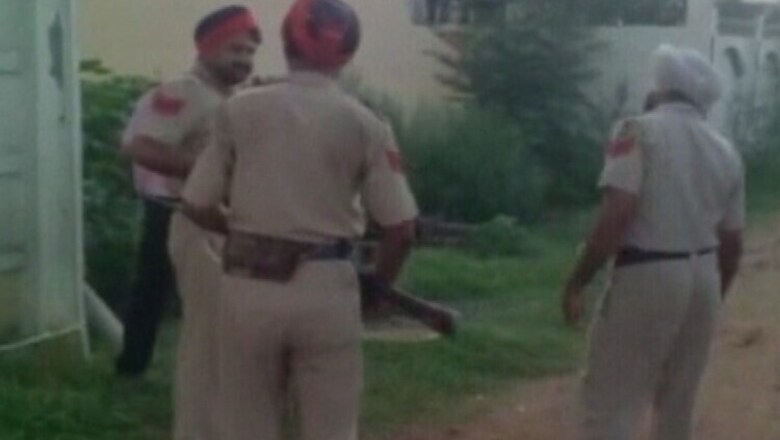
views
New Delhi: The terror attack on a police station in Gurdaspur district of Punjab has once again led to a fierce debate on the live coverage of anti-terror operations in India. When the incident came to the knowledge of the media, some television news channels and websites started doing the live coverage and minute to minute live updates of the operation. Within an hour, they realised their mistake and stopped doing the live coverage. They even repeatedly announced that they are not doing live coverage and are showing visuals only after a certain delay.
Even the Information and Broadcasting Ministry has informally asked the media not to jeopardise the operation by showing the live footage of the operation or doing live updates on the websites.
We are glad that the media has learnt some tough lessons after the 26/11 terror attacks on Mumbai in 2008. The entire anti-terror operation was live on TV news channels and the fierce competition between them even jeopardised the operation. According to security agencies, the handlers of the terrorists based in Karachi were closely monitoring the operation live on TV and alerting and guiding the terrorists holed up at Taj Hotel, Nariman House and Oberoi Trident. The local authorities were blamed for not cordoning off the area properly and preventing the media from doing live coverage.
In a hard-hitting analysis of 26/11 coverage for www.infochangeindia.org journalist Rashme Sehgal wrote that the deluge of near-hysterical reporting on TV brought a unanimous verdict from TV analysts. "It was not terror on TV but terror by TV, with TV channels unleashing their own brand of terror," pointed out journalist Anil Dharker. Film director Anurag Kashyap went a step further, saying, "All that the electronic media managed to do was propagate fear. They had no sense of protocol, complete disregard for the operation. Two senior journalists even went to the extent of fighting with each other over whose coverage was better. Shame!"
According to a report in 'The Hindu', the Supreme Court of India had slammed the electronic media for its live coverage of the 26/11 terrorist attacks. The Supreme Court said that by doing so, the Indian TV channels did not serve the national interest or any social cause during a hearing of 26/11 case in 2012.
A Bench of Justices Aftab Alam and CK Prasad, while confirming the death sentence on the prime accused, Ajmal Kasab, said the "reckless coverage gave rise to a situation where, on the one hand, the terrorists were completely hidden from the security forces and they had no means to know their exact positions or even the kind of firearms and explosives they possessed and, on the other, the positions of the security forces, their weapons and all their operational movements were being watched by the collaborators across the border on TV screens and being communicated to the terrorists.”
The Bench said, "Apart from the transcripts, we can take judicial notice of the fact that the terrorists’ attacks at all the places, in the goriest details, were shown live on Indian TV from beginning to end, almost non-stop. All the channels were competing with each other in showing the latest developments on a minute-to-minute basis, including the positions and the movements of the security forces engaged in flushing out the terrorists. In these appeals, it is not possible to find out whether the security forces actually suffered any casualty or injuries on account of the way their operations were being displayed on the TV screen. But it is beyond doubt that the way their operations were freely shown made the task of the security forces not only exceedingly difficult but also dangerous and risky.”
The media also reluctantly admitted that it has committed a blunder and the self regulatory bodies of the media came out with certain guidelines.
History and Madness of Live Coverage
The Indian TV channels started doing live coverage of such incidents during the Kargil war of 1999. They lugged their sophisticated live equipments to border posts and did live coverage from the frontlines of war to tell the nation that they were there. A noted journalist with a TV news channel was even accused of giving away the exact location of an army bunker in her live reporting, which reportedly cost the lives ten Indian soldiers after the Pakistan army launched a missile on it. Whatever may be her defence, she will have to live with it forever.
A blogger who runs a blog site called ‘greatbong.net’ wrote a scathing and thought provoking blog immediately after the 26/11 terror attack. His blog led to a fierce debate on the live coverage in social media.
He wrote –
The most common criticisms of the Indian television media coverage of 26/11 may be summarized as follows:
1. By showing live footage of commandos going in and in focusing attention on that hotel guest one can see on the ninth floor, they compromised the security of hostages and of the entire operation.
2. The channels fell over themselves trying to get exclusives, stooping to the level of harrying already distraught victims for their “reactions”.
3. The spotlight was entirely on the Taj and the Oberoi and not on Victoria Terminus because the victims at VT were, to put it bluntly, “low class” in contrast to the glitterati and foreigners at the 5-star hotels.
4. Other important events like the death of VP Singh were ignored in the midst of the 24/7 media brouhaha.
What however makes Indian media channels frequently insufferable are the personalities and the attitudes of the superstar anchors. While not cutting off people in mid-sentence or bullying guests or imposing their own opinions on others or getting in the way or repeating how these scenes are being brought live only by so-and-so-channel, these media superstars are usually found at the scene of every high-visibility news event, thrusting themselves into the centre stage rather than just reporting the god-damned thing. Lest this sound like a criticism of only Indian anchors this ego-centrism has been a standard criticism of most world super-star anchors—-from legends like Dan Rather to unalloyed gasbags like Bill O’Reilly—each of these media figures have been accused of getting so caught up in their own mystique that the focus of their stories end up becoming just one thing—- themselves.
He added that then again, somewhere down the line, and in the middle of the millions of investment dollars, the private news media themselves became unbalanced, sacrificing plain and simple common sense, basic journalistic ethics and media responsibility at the altar of the TRP devi. And its not as if the channels are extremely independent either, almost all of them have their political biases and agendas.
The sobering truth is that with increased competition, the commercialization of news (which includes sensationalism and the obscene rush for “exclusives”) is only going to get worse. If one wants to look at what the Indian media landscape will be a few years hence, then the state of the US television media as it is today serves as a fairly accurate crystal ball. The cable news revolution began in the US during the Gulf war of 1991 where CNN brought to American viewers the first “war on prime time” where an entire generation sat down to steak and potatoes and watched with rapt attention Patriots and Tomhawks raining down on the enemy. The line between news and entertainment was blurred forever and viewership of the classical news anchors like Tom Brokaw, Ted Koppell, Dan Rather were eaten into by the louder, more opinionated, shallower hosts on cable news.
Live Coverage and the West
The media in the West (Europe and America/Canada) is more balanced when compared their counterparts in India and other South Asian countries. Whenever a terror attack takes place, they show restraint and avoid giving operational details. Even the security agencies in the West are much more stricter and don’t share operational details with the media like some Indian security agency bosses. After the 9/11 incident in USA, they have become more restrained in their coverage of such incidents.
Self Regulation, Government Guidelines and Indian Media
According to a report in ‘Times of India’, live coverage of terror operations will be restricted to a periodic briefing by authorities with visual coverage at and around the scene of crime banned.
A new clause has been added to the program code of the Cable Television Network Rules that says that no program should be carried in the cable service that "contains live coverage of anti-terrorist operation by security forces, wherein media coverage shall be restricted to periodic briefing by any officer designated by the appropriate government, till such operation concludes."
"Anti-terrorist operation" has been defined as such "operation undertaken to bring terrorists to justice, which includes all engagements involving justifiable use of force between security forces and terrorists." Violation of the program code can lead to being yanked off air for a period of time or permanent revocation of the broadcaster's license in accordance with the Cable Television Network (Amendment) Act.
Incidentally, the two recent terror attacks in J&K— in Kathua and Samba district — were also covered by TV channels prompting the ministry to issue an advisory against the coverage. The ministry asked TV channels not to focus on location, strength, movement, strategy and other related operations being followed by security forces engaging with the terrorists.
Saumya Ramakrishnan wrte in Bar & Bench that in April 2012, a Private Member’s Bill called the “Print and Electronic Media Standards and Regulation Bill, 2012” was circulated in the Parliament, drafted by Congress MP Meenakshi Natarajan. However, she was absent the day she was scheduled to introduce in the Parliament and hence the Bill, till date, has not been placed before the House.
The Bill calls for the establishment of a media regulatory authority which has the power to ban or suspend the coverage of an event or incident that may pose a threat to national security from foreign or internal sources. The seven-member regulatory body, which would be selected by a panel consisting of a Supreme Court judge, the Information and Broadcasting Minister and three members appointed by the central government, would have powers equivalent to that of a civil court. Thus, it excludes the stakeholders in the media and deprives them of a voice in issues that affect them directly. Also, the Bill proposed a fine of upto Rs 50 lakh on media houses that commit offences specified under the Bill. The other penalties included a ban of up to eleven months on the offenders, or in severe cases, even cancellation of their license. While the Bill purports to create a water tight regulation for the media, it excludes the regulatory authority from the purview of the Right to Information Act, thus giving itself total control to oversee media activities without itself being accountable to any other body. Besides, a provision in the Bill – “no civil court will have jurisdiction of any matter which the Authority is empowered to determine” – takes away any scope of appeal, thus branding the authority as the most empowered one to decide on matters which come under its purview.
Moral Responsibility
Debates aside, exercising self restraint whenever there is a terror attack is the moral responsibility of the media. It can’t do live coverage for the sake of TRPs. Media has no right to jeopardise the operations by the security agencies risking the lives of the people. Media can’t hide behind ‘freedom of expression’ to defend its live coverage. Indian media is slowly realising it for the good.



















Comments
0 comment